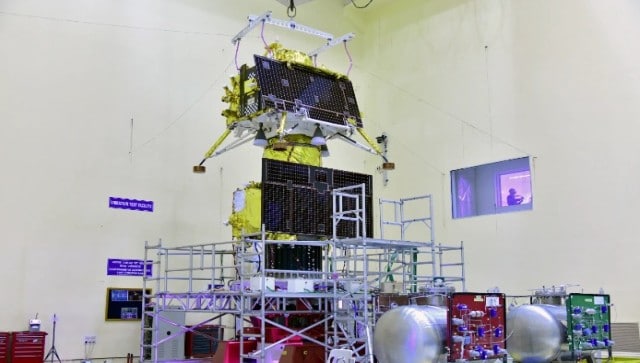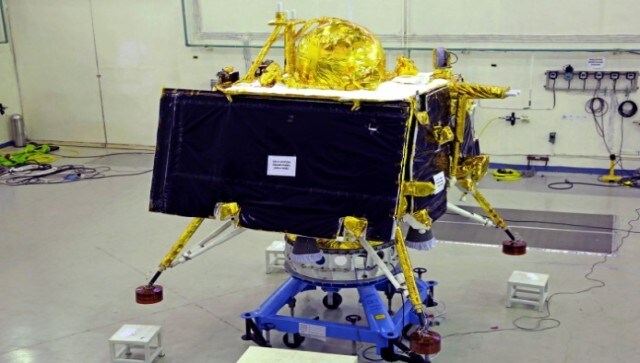The Moon has attracted both scientific and romantic interest for a very long time. India, too, has been pushing its boundaries by exploring the lunar surface for more than ten years. The highly awaited
Chandrayaan-3
, the third iteration of the Indian Space Research Organisation’s lunar mission, would launch in the intended launch window from 12 to 19 July, according to an ambitious plan presented by the national space agency. ISRO chairman S Somanath, while speaking at Kothavara St Xavier’s College, Vaikam in Kottayam district, said that the Chandrayaan has already reached the launch pad in Satish Dhawan Space Centre, Sriharikota from UR Rao Satellite Centre. “The final preparations are going on. It will be completed by the end of this month. The rocket, LVM-3, is going to be used for this launch and its assembly is going on. All parts for its assembly have reached Sriharikota. It will be launched between 12 and 19 July,” he said, according to ANI. He said that in order to avoid any problems during the upcoming launch, corrections have been made in Chandrayaan-3, in its hardware, structure, computers, software, and sensors. The third lunar exploration mission The Chandrayaan-3 spacecraft is ISRO’s third intended moon exploration mission. According to ISRO, the three mission objectives of the Chandrayaan-3 are- to demonstrate a safe and soft landing on the lunar surface; to demonstrate Rover roving on the moon and to conduct in-situ scientific experiments. [caption id=“attachment_12742282” align=“alignnone” width=“640”] The highly awaited Chandrayaan-3 would launch in the intended launch window from 12 to 19 July. Image Courtesy: ISRO[/caption] Following the
Vikram lander’s
disastrous landing during
Chandrayaan-2
, Chandrayaan-3 became necessary. With the help of Japan, India plans to conduct the proposed lunar polar exploration mission in 2024, and this new mission is meant to show the crucial landing techniques needed for that mission, according to News18. Chandrayaan-3 will be launched by the LVM3 (Launch Vehicle Mark 3) from the Satish Dhawan Space Centre (SDSC) SHAR in Sriharikota. It has a Lander and Rover configuration. According to a report by India.com, the propulsion module will carry the Lander and Rover configuration to a lunar orbit of about 100 miles. The Spectro-polarimetry of Habitable Planet Earth (SHAPE) payload, which is intended to undertake spectral and polarimetric studies of Earth from the lunar orbit, is mounted atop the propulsion module. From a special vantage position on the Moon, this payload will offer important information and insights about the features and habitability of the Earth. Also read: Chandrayaan 2: how does ISRO’s 978 crore moon mission fit into India’s global space ambitions? Key features & design Chandrayaan-3 won’t have an orbiter like Chandrayaan-2; instead, it will be made up of a rover and a lander. The mission seeks to investigate the Moon’s surface, especially regions that haven’t seen sunlight in billions of years. The launcher identified for Chandrayaan-3 is GSLV-Mk3 which will place the integrated module in an Elliptic Parking Orbit (EPO) of size 170 x 36500 km, reported ANI. In these remote areas, scientists and astronomers believe there may be ice and significant mineral deposits. News18 quoted its sources as saying that the expedition won’t be restricted to the surface but will also concentrate on researching the exosphere and subsurface. [caption id=“attachment_12742292” align=“alignnone” width=“640”]
The highly awaited Chandrayaan-3 would launch in the intended launch window from 12 to 19 July. Image Courtesy: ISRO[/caption] Following the
Vikram lander’s
disastrous landing during
Chandrayaan-2
, Chandrayaan-3 became necessary. With the help of Japan, India plans to conduct the proposed lunar polar exploration mission in 2024, and this new mission is meant to show the crucial landing techniques needed for that mission, according to News18. Chandrayaan-3 will be launched by the LVM3 (Launch Vehicle Mark 3) from the Satish Dhawan Space Centre (SDSC) SHAR in Sriharikota. It has a Lander and Rover configuration. According to a report by India.com, the propulsion module will carry the Lander and Rover configuration to a lunar orbit of about 100 miles. The Spectro-polarimetry of Habitable Planet Earth (SHAPE) payload, which is intended to undertake spectral and polarimetric studies of Earth from the lunar orbit, is mounted atop the propulsion module. From a special vantage position on the Moon, this payload will offer important information and insights about the features and habitability of the Earth. Also read: Chandrayaan 2: how does ISRO’s 978 crore moon mission fit into India’s global space ambitions? Key features & design Chandrayaan-3 won’t have an orbiter like Chandrayaan-2; instead, it will be made up of a rover and a lander. The mission seeks to investigate the Moon’s surface, especially regions that haven’t seen sunlight in billions of years. The launcher identified for Chandrayaan-3 is GSLV-Mk3 which will place the integrated module in an Elliptic Parking Orbit (EPO) of size 170 x 36500 km, reported ANI. In these remote areas, scientists and astronomers believe there may be ice and significant mineral deposits. News18 quoted its sources as saying that the expedition won’t be restricted to the surface but will also concentrate on researching the exosphere and subsurface. [caption id=“attachment_12742292” align=“alignnone” width=“640”] What is carried on the GSLV-MkIII rocket differs significantly between the two missions. Image Courtesy: ISRO[/caption] An orbiter from
Chandrayaan-2
will be used by the rover to contact Earth. Images taken from 100 km above the lunar orbit will be used to analyse the surface. Four throttle-able engines will power the Chandrayaan-3 lander, which will also have a Laser Doppler Velocimeter (LDV). “More fuel added and the landing legs have been strengthened. For producing more energy big solar panels have been fixed. And an additional sensor is also added. To measure its speed, a ‘Laser Doppler VelociMeter’ instrument, which was developed in the last year, has been added. We have also changed its algorithm and new software has been added to help Chandrayaan to land in another area if there is any failure at the scheduled spot,” said the ISRO chairman. Also read: Chandrayaan 2 represents best of scientific spirit in India, obscurantism of public figures the worst Its different from Chandrayaan 2 What is carried on the GSLV-MkIII rocket differs significantly between the two missions, according to India Today. Chandrayaan-3 will launch with merely a lander and a rover, as opposed to Chandrayaan-2, which also had an orbiter, a rover, and a lander called the Vikram. For its communication and terrain mapping needs, it will make use of the orbiter that is now circling the Moon and was launched with Chandrayaan-2. In addition, ISRO made some additional obvious adjustments to the Chandrayaan-3 mission in response to the lessons it learned from the loss of Chandrayaan-2. Lander Hazard Detection & Avoidance Cameras are being launched with the new mission, and they will be used to communicate with the orbiter and mission control when the lander approaches the Moon’s surface. Chandryaan-3 has two such cameras, compared to Chandryaan-2’s one such camera. [caption id=“attachment_12742302” align=“alignnone” width=“640”]
What is carried on the GSLV-MkIII rocket differs significantly between the two missions. Image Courtesy: ISRO[/caption] An orbiter from
Chandrayaan-2
will be used by the rover to contact Earth. Images taken from 100 km above the lunar orbit will be used to analyse the surface. Four throttle-able engines will power the Chandrayaan-3 lander, which will also have a Laser Doppler Velocimeter (LDV). “More fuel added and the landing legs have been strengthened. For producing more energy big solar panels have been fixed. And an additional sensor is also added. To measure its speed, a ‘Laser Doppler VelociMeter’ instrument, which was developed in the last year, has been added. We have also changed its algorithm and new software has been added to help Chandrayaan to land in another area if there is any failure at the scheduled spot,” said the ISRO chairman. Also read: Chandrayaan 2 represents best of scientific spirit in India, obscurantism of public figures the worst Its different from Chandrayaan 2 What is carried on the GSLV-MkIII rocket differs significantly between the two missions, according to India Today. Chandrayaan-3 will launch with merely a lander and a rover, as opposed to Chandrayaan-2, which also had an orbiter, a rover, and a lander called the Vikram. For its communication and terrain mapping needs, it will make use of the orbiter that is now circling the Moon and was launched with Chandrayaan-2. In addition, ISRO made some additional obvious adjustments to the Chandrayaan-3 mission in response to the lessons it learned from the loss of Chandrayaan-2. Lander Hazard Detection & Avoidance Cameras are being launched with the new mission, and they will be used to communicate with the orbiter and mission control when the lander approaches the Moon’s surface. Chandryaan-3 has two such cameras, compared to Chandryaan-2’s one such camera. [caption id=“attachment_12742302” align=“alignnone” width=“640”] The launcher identified for Chandrayaan-3 is GSLV-Mk3 which will place the integrated module in an Elliptic Parking Orbit (EPO) of size 170 x 36500 km. Image Courtesy: ISRO[/caption] The Chandrayaan-2 Orbiter was launched with an outstanding list of nine in-situ instruments that are still in use in the Moon’s orbit, which is a significant distinction between the two versions. In contrast, the Chandrayaan-3 mission’s propulsion module will only have the Spectro-polarimetry of HAbitable Planet Earth (SHAPE) instrument. The information will be utilised to research exoplanets and develop a yardstick for judging whether or not exoplanets outside the Solar System are habitable. “Future discoveries of smaller planets in reflected light would allow us to probe into a variety of exoplanets which would qualify for habitability, or for the presence of life,” ISRO said. The Laser Retroreflector Array (LRA), a passive experiment to comprehend the dynamics of the Moon system, is being sent with the lander as an adjunct to the Chandrayaan-3 mission. The Vikram lander from Chandrayaan-2 is the same as the other three payloads being launched with the mission. With inputs from ANI Read all the
Latest News
,
Trending News
,
Cricket News
,
Bollywood News
, India News
and
Entertainment News
here. Follow us on
Facebook
,
Twitter
and
Instagram
.
The launcher identified for Chandrayaan-3 is GSLV-Mk3 which will place the integrated module in an Elliptic Parking Orbit (EPO) of size 170 x 36500 km. Image Courtesy: ISRO[/caption] The Chandrayaan-2 Orbiter was launched with an outstanding list of nine in-situ instruments that are still in use in the Moon’s orbit, which is a significant distinction between the two versions. In contrast, the Chandrayaan-3 mission’s propulsion module will only have the Spectro-polarimetry of HAbitable Planet Earth (SHAPE) instrument. The information will be utilised to research exoplanets and develop a yardstick for judging whether or not exoplanets outside the Solar System are habitable. “Future discoveries of smaller planets in reflected light would allow us to probe into a variety of exoplanets which would qualify for habitability, or for the presence of life,” ISRO said. The Laser Retroreflector Array (LRA), a passive experiment to comprehend the dynamics of the Moon system, is being sent with the lander as an adjunct to the Chandrayaan-3 mission. The Vikram lander from Chandrayaan-2 is the same as the other three payloads being launched with the mission. With inputs from ANI Read all the
Latest News
,
Trending News
,
Cricket News
,
Bollywood News
, India News
and
Entertainment News
here. Follow us on
Facebook
,
Twitter
and
Instagram
.
ISRO to launch Chandrayaan-3 in July: Why this project is special
FP Explainers
• June 15, 2023, 14:05:33 IST
Chandrayaan-3 is a follow-on mission to Chandrayaan-2 to demonstrate end-to-end capability in safe landing and roving on the moon. ISRO has made additional adjustments to the new mission in response to the lessons it learned from the loss of Chandrayaan-2
Advertisement
)